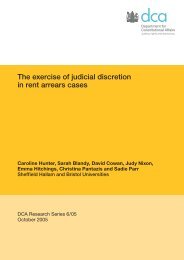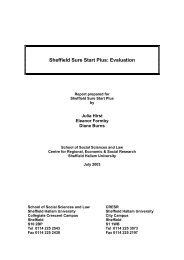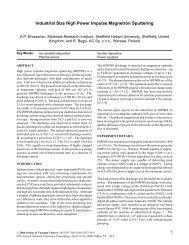Hallam Centre for Community Justice Briefing Paper: Sex Offender ...
Hallam Centre for Community Justice Briefing Paper: Sex Offender ...
Hallam Centre for Community Justice Briefing Paper: Sex Offender ...
You also want an ePaper? Increase the reach of your titles
YUMPU automatically turns print PDFs into web optimized ePapers that Google loves.
<strong>Hallam</strong> <strong>Centre</strong> <strong>for</strong> <strong>Community</strong> <strong>Justice</strong><br />
<strong>Briefing</strong> <strong>Paper</strong>:<br />
<strong>Sex</strong> <strong>Offender</strong> Registration - a Review of<br />
Practice in the United Kingdom, Europe<br />
and North America<br />
January 2009<br />
Compiled by Joanna Davidson<br />
<strong>Sex</strong> offender registration can be traced to the USA where<br />
sex offender registers began in Arizona and Cali<strong>for</strong>nia in<br />
the 1940s, but it was not until the 1950s that increased<br />
public awareness of sexual offending caused politicians to<br />
introduce registers <strong>for</strong> all states and ultimately public<br />
access to those registers (Thomas 2003: 218-219). Views<br />
on the use of sex offender registration differ across<br />
countries, with the USA at one end of the spectrum,<br />
revealing the details of sex offenders on a searchable<br />
website. The UK and Canada, although not at this stage<br />
yet are moving in the direction of the approach taken by<br />
the USA (Petrunik and Deutschmann 2007: 508). Europe,<br />
at the opposite end of the spectrum favours the<br />
combination of medical and psychological approaches.<br />
This briefing paper provides an overview of the<br />
background to sex offender registration, in the UK,<br />
Europe, the USA and Canada as well as the current<br />
situation, potential future directions <strong>for</strong> the practice and<br />
alternative approaches to dealing with sex offenders.<br />
-1-<br />
Contents<br />
Background and Introduction 2<br />
Approaches to the<br />
Registration of <strong>Sex</strong> <strong>Offender</strong>s 3<br />
Landmark Decisions <strong>for</strong> <strong>Sex</strong><br />
<strong>Offender</strong> Registration 4<br />
Current Arrangements 6<br />
Future of <strong>Sex</strong> <strong>Offender</strong><br />
Registration 7<br />
Alternative Options <strong>for</strong> Dealing<br />
with <strong>Sex</strong> <strong>Offender</strong>s 9<br />
References 11
Background and Introduction<br />
<strong>Sex</strong> offender policy is one of the most controversial areas of criminal justice policy. The<br />
hatred of sex offenders as a group is unequalled by popular attitudes to any other kind of<br />
offender (Sampson, 1994; Wakefield, 2006 in Jung and Nutley 2008: 189). There<strong>for</strong>e<br />
policies and procedures relating to sex offenders have been said to be driven by public<br />
outcries following highly publicised sex offences (Rad<strong>for</strong>d 2007 in Jung and Nutley 2008:<br />
189).<br />
Purpose of <strong>Sex</strong> <strong>Offender</strong> Registration<br />
The ultimate goal of sex offender legislation is to create safer societies (Meloy et al. 2007:<br />
439). Petrunik and Deutschmann (2007: 509) note that Europe, the UK, the USA, Canada,<br />
Australia and New Zealand have all had triggers <strong>for</strong> public outrage against sex offender. The<br />
assumption that sex offenders recidivate more than other offenders is a central motivation<br />
<strong>for</strong> registration and notification laws. The public will support surveillance of those it believes<br />
poses them a threat, in order to feel secure, particularly in a society where anxiety is linked<br />
to perceptions of crime, disorder and the dangerous classes. However, many crime control<br />
initiatives may actually serve to heighten their sense of fear and insecurity (Petrunik and<br />
Deutschmann 2007: 501).<br />
Rates of Recidivism<br />
• Hanson and Bussiere (1998: 357) noted that as a group, sex offenders have a low rate<br />
of recidivism. 13.4% of 23,393 were known to have committed a new sexual offence<br />
within the average 4-5 year follow up. Even in studies with thorough record searches<br />
and long follow up periods (15-20 years) the recidivism rates almost never exceed<br />
40%.<br />
• There is a lack of support <strong>for</strong> the idea that notification reduces recidivism. Firstly there<br />
are difficulties around reliably estimating whether notification statutes have worked and<br />
there is only limited support <strong>for</strong> the reduction of recidivism as a result of registration<br />
(Welchans 2005 in Mercado et al. 2008: 189). Schram and Milloy (1995 in Mercado et<br />
al. 2008: 189) found that the sexual recidivism rate of sex offenders was not<br />
significantly different from that of a comparison group of sex offenders who were not<br />
subject to notification.<br />
• In the UK, the compliance rate <strong>for</strong> the sex offender register was high; by 2000 it was<br />
estimated at 94.7%, (Plotnikoff and Woolfson 2000: 6 in Thomas 2008: 229) rising to<br />
97% by 2001 (Home Office/Scottish Executive 2001: 12 in Thomas 2008: 229). The<br />
numbers on the 'register' also rose steadily, reaching from about 15,000 in 2001 to just<br />
under 30,000 in 2006 (Thomas 2008: 229).<br />
• In the USA, it is reported that stigma associated with community notification may<br />
inadvertently increase the likelihood of recidivism among some sex offenders, in<br />
particular those who are low-risk by making it more difficult <strong>for</strong> them to achieve<br />
meaningful stability in important areas of their lives and facilitate positive relationships<br />
(Meloy et al. 2007: 438).<br />
-2-
Approaches to the Registration of <strong>Sex</strong><br />
<strong>Offender</strong>s<br />
The United Kingdom<br />
In the UK, sex offenders are treated as criminals who have a choice. The Home Office<br />
believed that a UK register would:<br />
a) Help (the police) identify suspects once a crime had been committed<br />
b) Possibly help them to prevent such crimes and<br />
c) It might act as a deterrent to potential re-offenders<br />
'The register was not a <strong>for</strong>m of punishment or a sentence of the court, but an add on<br />
additional feature designed in the interests of public and child protection. It was a regulatory<br />
feature that followed automatically from a conviction and a sentence, and the Home Office<br />
has always been quite clear that it is: 'a measure aimed at helping to protect the community<br />
from sex offenders not an additional penalty <strong>for</strong> the sex offender' (Home Office 1996 in<br />
Thomas 2008: 228).<br />
Europe<br />
Europeans believe that sex offenders are sick but curable (Petrunik and Deutschmann 2007:<br />
502). Their approaches focus more on psychiatry in assessment, treatment and<br />
management (CEP Workshop Publication 2003). Nordic, Baltic and Germanic countries<br />
favour chemical castration and psychotherapy and behavioural therapies (Petrunik and<br />
Deutschmann 2007: 502). 'Europeans generally have systems that although moving toward<br />
more surveillance, remain focused on the medical model and are less stigmatising and less<br />
likely to involve permanent exclusion from society' (Petrunik and Deutschmann 2007: 505).<br />
United States of America<br />
North America's approach to sex offenders is that they are 'evil' and incurable (Petrunik and<br />
Deutschmann 2007: 502). <strong>Community</strong> notification through Megan's Law is not seen as an<br />
additional punishment but as a <strong>for</strong>m of regulation to achieve greater community safety and<br />
public protection (Thomas 2003: 217). There has been an increasing trend among 'Anglo-<br />
American' societies to widen their social control nets by creating new kinds of sexual<br />
offences, such as sexual exploitation and invitation to sexual touching (Jenkins 1998 in<br />
Petrunik and Deutschmann 2007: 500).<br />
Canada<br />
Canada is 'in the middle' in terms of its approach to the registration of sex offenders<br />
(Petrunik and Deutschmann 2007: 508). Canada rely on the parole system to help manage<br />
the gradual and supported release of offenders; sex offenders tend to be let out on the last<br />
day of their sentence as they are considered to present the highest risk, however this<br />
approach may not be helpful <strong>for</strong> the offenders as they have no time in which to be reintroduced<br />
into life in the community. Canada has two sex offender registration systems,<br />
both at regional and national levels, however notification is limited and details of sex<br />
offenders are only revealed where necessary. Canada has also developed restorative<br />
community justice approaches (Petrunik and Deutschmann 2007: 505).<br />
-3-
Landmark Decisions <strong>for</strong> <strong>Sex</strong> <strong>Offender</strong><br />
Registration<br />
The United Kingdom<br />
<strong>Sex</strong> <strong>Offender</strong>s Act 1997 - The sex offenders register contains details of anyone convicted,<br />
cautioned or released from prison <strong>for</strong> sexual offence against children or adults since<br />
1997(Batty 2006):<br />
• Part I of the Act imposes a requirement on certain sex offenders to notify the police of<br />
their name(s) and address and any changes to these details in order to ensure that the<br />
in<strong>for</strong>mation on sex offenders contained within the police national computer is kept fully<br />
up to date (Home Office Press Release 1997).<br />
• The purpose of Part II of the Act is to give United Kingdom courts jurisdiction to deal<br />
with those who commit certain sexual acts against children abroad (Home Office Press<br />
Release 1997).<br />
<strong>Sex</strong>ual Offences Act 2003<br />
• A new order to make those known to have been convicted of sex offences overseas<br />
register as sex offenders when they come back to the UK, whether or not they have<br />
committed a crime here<br />
• All those on the sex offenders' register to confirm their details in person annually<br />
• <strong>Offender</strong>s on the register to provide NI details as a further safeguard against evasion.<br />
And new powers to enable the police to cross-check details of offenders on the<br />
register with passport, NI and driving licence records, once the infrastructure is in<br />
place, so that the breaches can be identified more quickly.<br />
• The period within which a sex offender must notify the police of a change of name or<br />
address to be reduced from 14 days to three.<br />
• <strong>Sex</strong> <strong>Offender</strong> Orders and <strong>Sex</strong> <strong>Offender</strong> Restraining to be amalgamated into a <strong>Sex</strong>ual<br />
Offences Prevention Order (SOPO) and made available <strong>for</strong> anyone convicted of a<br />
violent offence where there is evidence they present a risk of causing serious sexual<br />
harm (Home Office Press Release 2003).<br />
Violent Crime Reduction Act 2006<br />
• New powers <strong>for</strong> the police to enter and search the house of a person on the sex<br />
offender 'register' in order to assess the risk they might pose by way of reoffending<br />
(Thomas 2008: 233).<br />
• Also in 2006, the Home Office announced the widening of the number of designated<br />
offences leading to inclusion on the register. Including: outraging public decency,<br />
inflicting grievous bodily harm or do unlawful damage and child abduction (Thomas<br />
2008: 234).<br />
Review of the protection of children from sex offenders - 2007<br />
• Suggested a series of measures that might be looked at including polygraphs,<br />
medication to reduce sexual desires, and the use of satellite tracking to monitor highrisk<br />
offenders. Also suggested the need <strong>for</strong> more in<strong>for</strong>mation to be notified to the<br />
police by those on the 'register'. This included: email addresses, passport numbers,<br />
bank account numbers, details of any children living in the same household,<br />
notification of any <strong>for</strong>eign travel - rather than travel over three days as at present, to<br />
report regularly to a police station if offenders register as homeless and the provision<br />
of DNA samples if not already given (Home Office 2007: 18 in Thomas 2008: 234).<br />
-4-
Europe<br />
Individual European countries have always had their own laws on sexual offending reflecting<br />
the cultures and expectations of those countries (Hebenton and Thomas 1999: 151).<br />
France<br />
1990s<br />
• French sex offenders who had served their sentences were offered anti-depressants<br />
and oestrogen to reduce their sex drive but this was not effective (Smith Duval 2004).<br />
Denmark<br />
1920s<br />
• Authorised preventive confinement legislation in 1925 (Lieb 2000: 433)<br />
Netherlands<br />
1920s<br />
• Addressed dangerous offenders in legislative initiatives, allowing combinations of<br />
criminal sentences, commitment to psychiatric institutions and special indeterminate<br />
sentences (The Netherlands, Ministry of <strong>Justice</strong> 1994 in Lieb 2000: 433).<br />
Italy<br />
• Introduced indeterminate confinement <strong>for</strong> socially dangerous recidivists, legislation that<br />
was modified in 1953 and 1975 (Lieb 2000: 434).<br />
Germany<br />
1933<br />
• A law created indeterminate preventive confinement in a penal institution <strong>for</strong> habitual<br />
offenders and dangerous sex offenders (Lieb 2000: 434).<br />
1997 - Natalie's Law<br />
• Significantly changed sex offender sentences and reduced the criminal history<br />
prerequisites <strong>for</strong> incapacitation sentences (Lieb 2000: 434).<br />
The United States of America<br />
1995 - Child Molester Identification Line<br />
• In<strong>for</strong>mation on the whereabouts of registered sex offenders was made available to the<br />
public (Megan's Law Website, accessed on 31/10/08).<br />
1991- Minnesota <strong>Sex</strong> <strong>Offender</strong> Registration Act<br />
• The first organised and complied list of sex offenders which came out of the search <strong>for</strong><br />
Jacob Wetterling (Stevens unknown).<br />
1994 - Jacob Wetterling Crimes Against Children and <strong>Sex</strong>ually Violent <strong>Offender</strong><br />
Registration Act<br />
• Requires states to implement a sex offender and crimes against children registry (US<br />
Department of <strong>Justice</strong> Website, accessed on 9/10/08).<br />
1996 - Megan's Law<br />
• Amends Wetterling Act; requires states to establish a community notification system<br />
(US Department of <strong>Justice</strong> Website, accessed on 9/10/08).<br />
1998 - Amendments to the Jacob Wetterling Act<br />
-5-
• Include heightened registration requirements <strong>for</strong> sexually violent offenders and<br />
participation in the National <strong>Sex</strong> <strong>Offender</strong> Registry (US Department of <strong>Justice</strong> Website,<br />
accessed on 9/10/08).<br />
2000 - The Campus <strong>Sex</strong> Crimes Prevention Act<br />
• Amends Wetterling Act; requiring offenders to report in<strong>for</strong>mation regarding any<br />
enrolment or employment at an institution of higher education and to provide this<br />
in<strong>for</strong>mation to a law en<strong>for</strong>cement agency whose justification includes the institution<br />
(US Department of <strong>Justice</strong> Website, accessed on 9/10/08).<br />
2006 - Adam Walsh Child Protection and Safety Act<br />
• The purpose of this act is to try and protect children from exploitation and violent crime<br />
(Stevens, unknown).<br />
Canada<br />
Christopher's Law - 2001<br />
• Ontario was the first jurisdiction in Canada with a sex offender's register (Friscolanti<br />
2008a).<br />
<strong>Sex</strong> <strong>Offender</strong> In<strong>for</strong>mation Registration Act - 2004<br />
• Canada's national sex offender's registry which was introduced (Friscolanti 2008a).<br />
Current Arrangements<br />
The United Kingdom<br />
In the UK, the sex offenders register contains details of anyone convicted, cautioned or<br />
released from prison <strong>for</strong> sexual offence against children or adults since 1997, when it was<br />
established with the introduction of the <strong>Sex</strong> <strong>Offender</strong>s Act. The register is run by the police<br />
and is not retroactive. All convicted sex offenders must register within 3 days of their release<br />
or conviction. This is monitored by the police, who receive notification from the courts<br />
following conviction, and both the prison and probation service following an offender's<br />
release into the community (Batty 2006). The Home Office allows in<strong>for</strong>mation to be<br />
disseminated by police in a 'controlled' fashion to other professionals (<strong>for</strong> example, housing<br />
officials, schools, social services departments) and occasionally members of the public, <strong>for</strong><br />
example, victims of offenders but a general public right of access does not resist (Thomas<br />
2003: 218).<br />
Europe<br />
France<br />
France piloted the inhibition of sex offenders' sex drives via the use of drugs in 2004. The<br />
pilot involves a two year trial where repeat offenders will be offered counselling and<br />
treatment using two drugs that inhibit the development of male sex hormones. France will<br />
not make the treatment obligatory and would not consider voluntary chemical castration of<br />
sex offenders (Smith Duval 2004).<br />
Sweden<br />
Under the Criminal Code, indeterminate preventive detention is authorised. The internment<br />
sentencing allows a minimum of one and a maximum of twelve years institutional<br />
confinement. Extensions may be permitted by the court <strong>for</strong> three years at a time, with lifetime<br />
sentences possible if requested by the board (Sansone 1976 in Lieb 2000: 434). Sweden<br />
-6-
offer drugs to repeat sex offenders on a voluntary basis after they have left prison and in<br />
combination with psychotherapy (Smith Duval 2004).<br />
Denmark<br />
Offer drugs to repeat sex offenders on a voluntary basis after they have left prison and in<br />
combination with psychotherapy (Smith Duval 2004).<br />
Italy<br />
In Italy there is no national register of sex offenders (Fraser 2006).<br />
The United States of America<br />
Despite the implementation of the Jacob Wetterling Act, increased mobility within society has<br />
led to sex offenders being 'lost', i.e. those who fail to comply with registration duties yet<br />
remain undetected due to inconsistencies among state laws (missing kids.com, accessed on<br />
23/10/08). The introduction of the Adam Walsh Child Protection and Safety Act should see<br />
more accurate and up to date registries and increased ability of the state to provide support<br />
(US Department of <strong>Justice</strong> Website). Final guidelines were published <strong>for</strong> the Act in 2008;<br />
they provide direction and assistance to all jurisdictions in their ef<strong>for</strong>ts to meet the minimum<br />
standards of the Act (US Department of <strong>Justice</strong> Press Release 2008).<br />
Canada<br />
Canada has two sex offender registration systems, the province of Ontario's registry and the<br />
national registry and five provinces have a limited <strong>for</strong>m of notification under community<br />
safety legislation (Petrunik 2003 in Petrunik and Deutschmann 2007: 505). Under<br />
exceptional circumstances, extra controls can be applied that place limits on residency,<br />
association with others and movement in public places (Petrunik and Deutschmann 2007:<br />
505). A prosecutor must ask the judge to order a defendant onto the database, which does<br />
not always happen, often due to human error (Friscolanti 2008c). Authorities are only<br />
allowed to access the database after an incident has occurred and are not permitted to<br />
search the database themselves; they have to contact a specialist agency. A registered<br />
offender has to in<strong>for</strong>m police if they are going on holiday, but only if it is <strong>for</strong> longer than two<br />
weeks. Anything less than that does not need to be reported. Authorities are unable to share<br />
any in<strong>for</strong>mation on the proposed visits of sex offenders to <strong>for</strong>eign countries. Additionally,<br />
correctional services do not in<strong>for</strong>m registry officials when federal inmates are released,<br />
meaning that the RCMP is not aware of the fact that hundreds of offenders are expected to<br />
register (Friscolanti 2008a).<br />
Future of <strong>Sex</strong> <strong>Offender</strong> Registration<br />
The United Kingdom<br />
The Home Office is piloting the limited opening up of sex offender in<strong>for</strong>mation to parents<br />
worried about specific individuals who have access to their children. From June 2008, police<br />
can decide whether parents in Cambridgeshire, Cleveland, Hampshire, and Warwickshire<br />
can discover if a person who has access to their child has had any previous convictions <strong>for</strong><br />
child sex offences, if it is in the child's best interests. All parents must first sign an affidavit<br />
(Oates 2008).<br />
In August 2008 the Home Office announced new measures to strengthen restrictions against<br />
child sex offenders and build on the UK's existing regime. These new measures include:<br />
• Removing the need <strong>for</strong> recent evidence when the police are seeking a <strong>Sex</strong>ual<br />
Offences Prevention Order (SOPO)<br />
-7-
• Requiring registered sex offenders to notify the police earlier of their intentions to travel<br />
abroad<br />
• Automatic removal of an individual's passport when they are subject to a blanket<br />
<strong>for</strong>eign travel order<br />
• Extending the duration of a <strong>for</strong>eign travel order from the current six months (Home<br />
Office Press Release 2008)<br />
Also under consideration but yet to be approved are:<br />
• Further restrictions on passport issuance and validity<br />
• Raising the upper age limit concerning the child at risk (from 16 to 18) to allow <strong>for</strong> a<br />
Foreign Travel Order to be made <strong>for</strong> this age group in certain circumstances (Home<br />
Office Press Release 2008)<br />
Europe<br />
• European countries, such as France and Belgium have been slower to adopt registries<br />
than in the UK, USA and Canada although this is now beginning to change as the<br />
result of high profile incidents (Petrunik and Deutschmann 2007: 500).<br />
• A populas poll (<strong>for</strong> the Madeline McCann campaign) found 84% of MPs agreed that<br />
sex offenders should be tracked across Europe and <strong>for</strong>ced to register with local police.<br />
Nearly nine in ten also said that the Child Rescue Alert should be adopted across<br />
Europe. The initiative is in place within the UK and is designed to heavily publicise an<br />
abduction in the first few hours - described as the 'golden hour' by investigators<br />
(www.politics.co.uk, article - 23/8/07, accessed on 10/10/08).<br />
The United States of America<br />
• In the USA it appears that registration and notification requirements have been<br />
tightened, although it is questionable that community notification has actually led to a<br />
reduction in sex offences (Scott & Gerbasi 2003; Berlin 2003 in Weiss and Watson<br />
2008: 117).<br />
• The most up to date in<strong>for</strong>mation available highlights that the USA is focused on ways<br />
to increase public protection from sex offenders, particularly in ways outside of the<br />
context of the criminal law. Citizens and governments are pushing <strong>for</strong> specialised<br />
remedies and powers. Risk assessment, in terms of, not the actual event, but which<br />
individuals in a group pose the highest risk of reoffending will be an important<br />
component of future directions <strong>for</strong> sex offender registration in the USA (Lieb 2000:<br />
436-437).<br />
Canada<br />
• It has been revealed that hundreds of paedophiles and rapists are missing and<br />
hundreds more were never added to the system (Friscolanti 2008b). The sex offender<br />
registry is incomplete and there are problems with keeping track of those who are on<br />
the registry, many of whom are non-compliant (Friscolanti 2008b). Police and<br />
Government officials are now are working on a major overhaul of Canada's sex<br />
offender registry and increased communication with law en<strong>for</strong>cement after a magazine<br />
expose on the system (reported by Friscolanti 2008c).<br />
• A recent study in Canada showed that of 47,000 offenders, after 15 years, fewer than<br />
one quarter were rearrested <strong>for</strong> another sex crime. Those who undergo treatment are<br />
even less likely to reoffend. Often, offenders on the system are on their first offence,<br />
there<strong>for</strong>e the registry has not done its job in their case, of helping to prevent them<br />
committing crimes in the first place (Friscolanti 2008a).<br />
-8-
Alternative Options <strong>for</strong> Dealing with <strong>Sex</strong><br />
<strong>Offender</strong>s<br />
It is important to note that sex offender registration is not the only option available <strong>for</strong> dealing<br />
with sex offenders. This section provides a brief overview of alternative options in the United<br />
Kingdom and the United States of America.<br />
The United Kingdom<br />
• Surgical treatments - these procedures are now very rare due to the side effects and<br />
the fact that the procedure is irreversible. Includes chemical castration from which the<br />
evidence of effectiveness is ambiguous.<br />
• Pharmacological treatments - studies have found that anti-libidinal medication can be<br />
helpful; it is necessary to gain the in<strong>for</strong>med consent of offender and they have the<br />
ability to withdraw from taking the medication. However, this treatment is not suitable<br />
<strong>for</strong> all sex offenders and you have to assume that the medication is being taken.<br />
• Psychological treatments - helping the offender gain insight into how they acquired<br />
their offending behaviour/personality, helping them to control or remove what is<br />
maintaining the offending behaviour and helping to prevent a relapse when under<br />
stress/in high risk situations in the community. Treatment includes skills based<br />
interventions, behaviour modification and insight interventions. Including cognitivebehavioural<br />
approaches (Perkins et al. 1998: 7-9).<br />
• The <strong>Sex</strong> <strong>Offender</strong> Treatment Plan (STEP) began in 1991 as part of a national strategy<br />
<strong>for</strong> the integrated assessment and treatment of sex offenders; it is currently run in 25<br />
establishments. The central part of the SOPT is the core programme whose primary<br />
purpose is to increase the offender's motivation to avoid re-offending and to develop<br />
the self-management skills necessary to achieve this. Comprehensive assessment is<br />
also an integral part of the programme which in<strong>for</strong>ms decisions about the nature of<br />
future risk of the offender. At the moment the core programme consists of 86 sessions<br />
including additional elements such as role play. Group work plays a large role, allowing<br />
offenders to publicly admit that they need to change. The treatment approach is a<br />
cognitive behavioural one which is considered the most effective <strong>for</strong> this group. The<br />
cognitive aspect involves recognising the patterns of distorted thinking which allow the<br />
contemplation of illegal sexual acts and understanding the impact that sexually<br />
abusive behaviour has on its victims. The behavioural component of treatment<br />
involves reducing sex arousal to inappropriate fantasies of <strong>for</strong>ced sexual activities with<br />
children and adults (Beech et al. 1998: 5).<br />
• An evaluation of this study carried out in 1998 found that of the 56 men, who agreed to<br />
be seen at the 9 month follow up period, 32 were still in prison and 24 had been<br />
released. Overall they found that the treatment changes brought about by the Core<br />
Programme were maintained. They found that the longer the therapy the more<br />
successful it was in changing attitudes and instilling effective relapse prevention<br />
techniques (Beech et al. 1998: 8).<br />
Successful sex offender programmes are those which:<br />
• Address developmentally generated dispositions to offend; past, present and future<br />
• Address the development of offender insight, motivation not to offend and the skills<br />
necessary to avoid offending and achieve a non-offending lifestyle<br />
• Utilise treatment methods geared to the needs and capabilities of the offender in<br />
treatment<br />
-9-
• Utilise combinations of group and individual therapy as appropriate <strong>for</strong> different<br />
aspects of treatment and assessment (Perkins et al. 1998: 3)<br />
• Perkins et al. (1998: 18) in an analysis of studies found that the cognitive behavioural<br />
approach can demonstrably improve survival rates.<br />
• MAPPA (Multi-Agency Public Protection Arrangements) support the assessment and<br />
management of the most serious sexual and violent offenders. The aim of the MAPPA<br />
is to ensure that a risk management plan drawn up <strong>for</strong> the most serious offenders<br />
benefits from the in<strong>for</strong>mation, skills and resources provided by the individual agencies<br />
being coordinated through MAPPA. Key features: Identifying offenders to be<br />
supervised under MAPPA - there are three categories- 1. Registered sex offenders, 2.<br />
Violent or other sex offenders and 3. Other offenders. Also, sharing of in<strong>for</strong>mation,<br />
assessing the risks posed by offenders and managing the risk posed by individual<br />
offenders (MoJ Website).<br />
Plotnikoff and Woolfson (2000 in Jung and Nutley 2008: 194) highlighted several<br />
shortcomings in and concerns about existing arrangements to deal with sex offenders.<br />
These related to:<br />
• Deficiencies in the current legislation<br />
• Inadequate resources <strong>for</strong> monitoring offenders<br />
• Increased workloads<br />
• Fears that resources had been diverted away from other categories of higher-risk<br />
offenders<br />
• Timeliness and quality of the flow of in<strong>for</strong>mation from courts, prisons and hospitals<br />
regarding offenders required to register<br />
The creation of unrealistic expectations on the part of the public and other agencies<br />
The United States of America<br />
• Options in the USA - sex offender registration, community notification, involuntary civil<br />
commitment (involuntary confinement of a 'mentally disordered' sex offender after the<br />
completion of a prison term (La Fond 2000 in Meloy 2007: 426)) and mandatory sex<br />
offender therapy (Meloy et al. 2007: 437).<br />
• Residency restrictions laws - aim to increase public protection by limiting where sex<br />
offenders live. Their efficacy in reducing rates of sexual recidivism is unknown, their<br />
constitutionality has been questioned and their potential to increase re-offence risk has<br />
been noted. As yet there has been no research examining whether residency<br />
restrictions work specifically to reduce recidivism (Mercado et al. 2008: 190).<br />
• The literature evaluating the public safety impact of sex offender registration and<br />
community notification laws is scant (Meloy et al. 2007: 425).<br />
The most recent suggestions <strong>for</strong> dealing with sex offenders include:<br />
• Mandatory life sentences <strong>for</strong> some sex offenders<br />
• Global Positioning System which works in real time and also the possibility of<br />
incorporating exclusion zones so that the system sets off an alarm to law en<strong>for</strong>cement<br />
authorities if an offender enters into these restricted areas.<br />
• Monitoring <strong>for</strong> released offenders<br />
• Predator free child molester zones<br />
• A national sexual predator monitoring proposal (Meloy et al. 2007: 424).<br />
-10-
References<br />
Batty, D (18/1/06) Guardian Article: Q&A: The <strong>Sex</strong> <strong>Offender</strong>s Register, accessed at:<br />
http://www.guardian.co.uk/society/2006/jan/18/childrensservices.politics1/print, on 09/10/08.<br />
Beech, A., Fisher, D. and Beckett, R. (1998) Step 3: An Evaluation of the Prison <strong>Sex</strong> <strong>Offender</strong> Treatment<br />
Programme, prepared <strong>for</strong> the Home Office by the STEP Team<br />
Berlin, F.S. (2003) <strong>Sex</strong> offender treatment and legislation, Journal of American Academic Psychiatry and Law, 31:<br />
510-513. Cited in Weiss, K. J. and Watson, C. (2008) NGRI and Megan's Law: No Exit? Journal of American<br />
Academic Psychiatry Law, 36: 117-122<br />
CEP Workshop Publication (London, January 30-31 2003) The Management of Dangerous <strong>Sex</strong> <strong>Offender</strong>s: A<br />
European Perspective, accessed at: http://www.cepprobation.org/publications/reports/the_management_of_dangerous_sex_offenders.shtml<br />
Fraser, C (19/1/2006) BBC News Article: Global measures against sex offenders. Accessed at:<br />
http://news.bbc.co.uk/1/hi/uk_politics/4627232.stm, on 31/10/08<br />
Friscolanti, M (2008a) Canada's <strong>Sex</strong> <strong>Offender</strong> Registry a National Embarrassment, The Canadian Encyclopedia<br />
Historica, accessed at:<br />
http://www.thecanadianencyclopedia.com/index.cfm?PgNm=TCE&Params=M1ARTM0013190, on 14/10/08<br />
Friscolanti, M (2008b) The <strong>Sex</strong> <strong>Offender</strong> Registry-and your province, accessed at<br />
http://www.macleans.ca/article.jsp?content=20080114_103501_3068, on 24/11/08.<br />
Friscolanti, M (2008c) Fixing the <strong>Sex</strong> <strong>Offender</strong> Registry, The Canadian Encyclopedia Historica, accessed at<br />
http://www.thecanadianencyclopedia.com/index.cfm?PgNm=TCE&Params=M1ARTM0013263, on 24/11/08.<br />
Hanson, R. K. and Bussiere, M. T. (1998) Predicting relapse: a meta-analysis of sexual offender recidivism<br />
studies, Journal of Counselling and Clinical Psychology, 66 (2): 348-362<br />
Hebenton, B and Thomas T (1999) Capacity Building Against Transnational Crime: European Measures to<br />
Combat <strong>Sex</strong>ual <strong>Offender</strong>s, European Journal of Crime, Criminal Law and Criminal <strong>Justice</strong>, 7 (2): 150-163<br />
Home Office (1996) Sentencing and Supervision of <strong>Sex</strong> <strong>Offender</strong>s: A Consultation Document, Cm 3304. Cited in<br />
Thomas, T (2008) The <strong>Sex</strong> <strong>Offender</strong> 'Register': A Case Study in Function Creep, The Howard Journal, 47 (3):<br />
227-237 (page 228).<br />
Home Office (1997) Press Release: The <strong>Sex</strong> <strong>Offender</strong>s Act 1997, accessed at:<br />
http://www.crimereduction.homeoffice.gov.uk/sexual/sexual02.htm, on 20/11/08.<br />
Home Office/Scottish Executive (2001) Consultation <strong>Paper</strong> on the Review of Part 1 of the <strong>Sex</strong> <strong>Offender</strong>s Act<br />
1997, London/Edinburgh, Home Office/Scottish Executive. Cited in Thomas, T (2008) The <strong>Sex</strong> <strong>Offender</strong><br />
'Register': A Case Study in Function Creep, The Howard Journal, 47 (3): 227-237<br />
Home Office Press Release (2/12/03) Putting Victims First: Publication of the Domestic Violence, Crime and<br />
Victims Bill, accessed at http://press.homeoffice.gov.uk/pressreleases/Putting_Victims_First__Publicati?version=1,<br />
on 10/10/08<br />
Home Office Press Release (21/11/03) <strong>Sex</strong>ual Offences Bill Receives Royal Assent, accessed at:<br />
http://press.homeoffice.gov.uk/press-releases/<strong>Sex</strong>ual_Offences_Bill_Receives_Ro, on 10/10/08<br />
Home Office (2007) Review of the Protection of Children from <strong>Sex</strong> <strong>Offender</strong>s (June), London: Home Office. Cited<br />
in Thomas, T (2008) The <strong>Sex</strong> <strong>Offender</strong> 'Register': A Case Study in Function Creep, The Howard Journal, 47 (3):<br />
227-237 (page 234).<br />
Home Office Press Release (20/8/08) Tougher measures <strong>for</strong> child sex offenders, accessed at:<br />
http://press.homeoffice.gov.uk/press-releases/<strong>Sex</strong>-Offences, on 10/10/08<br />
Jenkins, P (1998) Moral Panic: Changing Concepts of the child molester in modern America. New Haven, CT:<br />
Yale University Press. Cited in Petrunik, M and Deutschmann, L (2007) The Exclusion Inclusion Spectrum in<br />
State and <strong>Community</strong> Response to <strong>Sex</strong> <strong>Offender</strong>s in Anglo-American and European Jurisdictions, International<br />
Journal of <strong>Offender</strong> Therapy and Comparative Criminology, 52: 499-519 (page 500).<br />
Jung, T and Nutley S. M. (2008) Evidence and policy networks: the UK debate about sex offender community<br />
notification, Evidence & Policy, 4 (2): 187-207<br />
La Fond, J. (2000) The future of involuntary civil commitment in the USA after Kansas vs. Hendricks, Behavioral<br />
Sciences and the Law, 18: 153-167. Cited in Meloy, M., Saleh, Y. and Wolff, N. (2007) <strong>Sex</strong> <strong>Offender</strong> Laws in<br />
America: Can Panic Driven Legislation ever Create Safer Societies? Criminal <strong>Justice</strong> Studies, 20 (4): 423-443<br />
Lieb, R (2000) Social Policy and <strong>Sex</strong>ual <strong>Offender</strong>s: Contrasting United States' and European Policies, European<br />
Journal on Criminal Policy and Research, 8 (4): 423-440<br />
Megan's Law Website Homepage, accessed at:<br />
http://meganslaw.ca.gov/homepage.aspx?lang=ENGLISH, on 31/10/08<br />
Meloy, M., Saleh, Y. and Wolff, N. (2007) <strong>Sex</strong> <strong>Offender</strong> Laws in America: Can Panic Driven Legislation ever<br />
Create Safer Societies? Criminal <strong>Justice</strong> Studies, 20 (4): 423-443<br />
Mercado, C. C., Alvarez, S. and Levenson, J. (2008) The Impact of Specialized <strong>Sex</strong> <strong>Offender</strong> Legislation on<br />
<strong>Community</strong> Reentry, <strong>Sex</strong> Abuse, 20: 188-205<br />
Missing Kids Website - <strong>Sex</strong> <strong>Offender</strong>s: History, accessed at<br />
http://www.missingkids.com/missingkids/servlet/PageServlet?LanguageCountry=en_US&PageId=3032, on<br />
23/10/08<br />
Ministry of <strong>Justice</strong> News Release (8/10/07) Greater protection against hate and sex crimes, accessed at:<br />
http://www.justice.gov.uk/news/newsrelease081007a.htm, on 16/10/08<br />
-11-
Ministry of <strong>Justice</strong> Website - Protecting the Public: Multi-Agency Public Protection Arrangements, accessed at<br />
http://www.noms.justice.gov.uk/protecting-the-public/supervision/mappa, on 17/12/08.<br />
Oates, J (posted in Government 18/2/08) The Register Article - Home Office open sex offender files in pilot<br />
scheme: Limited access under Violent Crime Action Plan, accessed at<br />
http://www.theregister.co.uk/2008/02/18/home_office_violent_crime/print.html, on 9/10/08<br />
Perkins, D., Hammond, S., Coles, D. and Bishopp, D. (1998) Review of <strong>Sex</strong> <strong>Offender</strong> Treatment Programmes,<br />
Department of Psychology, Broadmoor Hospital, prepared <strong>for</strong> the High Security Psychiatric Services<br />
Commissioning Board<br />
Petrunik, M and Deutschmann, L (2007) The Exclusion Inclusion Spectrum in State and <strong>Community</strong> Response to<br />
<strong>Sex</strong> <strong>Offender</strong>s in Anglo-American and European Jurisdictions, International Journal of <strong>Offender</strong> Therapy and<br />
Comparative Criminology, 52: 499-519<br />
Plotnikoff, J. and Woolfson, R. (2000) Where are they now? An evaluation of sex offender registration in England<br />
and Wales - Police Research Series <strong>Paper</strong> 126, London: Policing and Reducing Crime Unit. Cited in Jung, T<br />
and Nutley S. M. (2008) Evidence and policy networks: the UK debate about sex offender community<br />
notification, Evidence & Policy, 4 (2): 187-207<br />
Plotnikoff, J. and Woolfson, R. (2000) Where are they now? An evaluation of sex offender registration in England<br />
and Wales - Police Research Series <strong>Paper</strong> 126, London: Home Office. Cited in Thomas, T (2008) The <strong>Sex</strong><br />
<strong>Offender</strong> 'Register': A Case Study in Function Creep, The Howard Journal, 47 (3): 227-237<br />
Rad<strong>for</strong>d, B. (2007) Americans exaggerate threats posed by sexual predators, in L.M. Zott (ed) <strong>Sex</strong> <strong>Offender</strong>s and<br />
Public Policy, Chicago, IL: Greenhaven Press, pp 54-63. Cited in Jung, T and Nutley S. M. (2008) Evidence<br />
and policy networks: the UK debate about sex offender community notification, Evidence & Policy, 4 (2): 187-<br />
207<br />
Sampson, A. (1994) Acts of Abuse: <strong>Sex</strong> offenders and the criminal justice system. Cited in Jung, T and Nutley S.<br />
M. (2008) Evidence and policy networks: the UK debate about sex offender community notification, Evidence &<br />
Policy, 4 (2): 187-207<br />
Sansone, J. (1976) Sentencing, Corrections and Special Treatment Services in Sweden, Denmark and The<br />
Netherlands. Hart<strong>for</strong>d, CT: Hart<strong>for</strong>d Institute of Criminal and Social <strong>Justice</strong>. Cited in Lieb, R (2000) Social Policy<br />
and <strong>Sex</strong>ual <strong>Offender</strong>s: Contrasting United States' and European Policies, European Journal on Criminal Policy<br />
and Research, 8 (4): 423-440 (page 434).<br />
Schram, D. and Milloy, C. (1995) <strong>Community</strong> notification: a study of offender characteristics and recidivism<br />
(Report no. 95-10-1101), Olympia, Washington State Institute <strong>for</strong> Public Policy. Cited in Mercado, C. C.,<br />
Alvarez, S. and Levenson, J. (2008) The Impact of Specialized <strong>Sex</strong> <strong>Offender</strong> Legislation on <strong>Community</strong><br />
Reentry, <strong>Sex</strong> Abuse, 20: 188-205<br />
Scott, C. L. and Gerbasi, J. B (2003) <strong>Sex</strong> offender registration and community notification challenges: the<br />
Supreme court continues its trend, Journal of American Academic Psychiatry Law, 31: 494-501. Cited in Weiss,<br />
K. J. and Watson, C. (2008) NGRI and Megan's Law: No Exit? Journal of American Academic Psychiatry Law,<br />
36: 117-122<br />
Smith Duval, A (11/11/04) France introduces chemical castration <strong>for</strong> sex offenders, accessed at:<br />
http://www.independent.co.uk/news/world/europe/france-introduces-chemical-castration-<strong>for</strong>-sex-offenders-<br />
532792.html?service=Print<br />
Stevens, P (date unknown) History of the <strong>Sex</strong> <strong>Offender</strong> Registry, accessed at: http://sex-offender-registryreview.toptenreviews.com/history-of-the-sex-offender-registry.html,<br />
on 9/10/08<br />
The Netherlands, Ministry of <strong>Justice</strong> (1994) TBS: A Special Hospital Order of the Dutch Criminal Code.<br />
Memorandum of the Dutch Government. The Hague: Ministry of <strong>Justice</strong>. Cited in Lieb, R (2000) Social Policy<br />
and <strong>Sex</strong>ual <strong>Offender</strong>s: Contrasting United States' and European Policies, European Journal on Criminal Policy<br />
and Research, 8 (4): 423-440 (page 433).<br />
Thomas, T (2003) <strong>Sex</strong> <strong>Offender</strong> <strong>Community</strong> Notification: Experiences from America, The Howard Journal, 42 (3):<br />
217-228<br />
Thomas, T (2008) The <strong>Sex</strong> <strong>Offender</strong> 'Register': A Case Study in Function Creep, The Howard Journal, 47 (3):<br />
227-237<br />
US Department of <strong>Justice</strong> Website - <strong>Justice</strong> Programs Page - Overview and History of the Jacob Wetterling Act,<br />
accessed at: http://www.opj.usdoj.gov/BJA/what/2a1jwacthistory.html, on 9/10/08<br />
US Department of <strong>Justice</strong> - Press Release (1/7/08) 'Department of <strong>Justice</strong> Announces Final National Guidelines<br />
<strong>for</strong> <strong>Sex</strong> <strong>Offender</strong> Registration and Notification', accessed at<br />
http://www.ojp.usdoj.gov/newsroom.pressreleases/2008/smart08019.htm, on 24/11/08.<br />
Wakefield, H. (2006) The vilification of sex offenders: do laws targeting sex offenders increase recidivism and<br />
sexual violence? Journal of <strong>Sex</strong>ual <strong>Offender</strong> Civil Commitment: Science and the Law, 1: 141-149. Cited in Jung,<br />
T and Nutley S. M. (2008) Evidence and policy networks: the UK debate about sex offender community<br />
notification, Evidence & Policy, 4 (2): 187-207<br />
Weiss, K. J. and Watson, C. (2008) NGRI and Megan's Law: No Exit? Journal of American Academic Psychiatry<br />
Law, 36: 117-122<br />
Welchans, S. (2005) Megan's Law: Evaluations of <strong>Sex</strong> <strong>Offender</strong> Registries, Criminal <strong>Justice</strong> Policy Review, 16:<br />
123-140. Cited in Mercado, C. C., Alvarez, S. and Levenson, J. (2008) The Impact of Specialized <strong>Sex</strong> <strong>Offender</strong><br />
Legislation on <strong>Community</strong> Reentry, <strong>Sex</strong> Abuse, 20: 188-205<br />
www.politics.co.uk (23/8/07) article 'MPs back Europe-wide sex offenders register', accessed at:<br />
http://www.politics.co.uk/printerfriendly.aspx?itemid=477586, on 10/10/08<br />
-12-
















